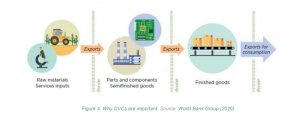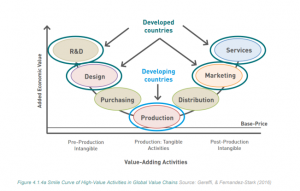Lesson 3: What are GVC
In this lesson, we will delve into the concept of Global Value Chains (GVCs), their dimensions, and their role in shaping the global economy.
- Understanding the Value Chain
- The value chain encompasses all activities that firms and workers undertake to take a product from its conception to its end use and beyond.
- These activities include research and development (R&D), design, production, marketing, distribution, and support to the final consumer.
- A value chain can exist within a single firm or span across multiple firms in a global context.
- Globalization of Value Chains
- In the era of globalization, value chain activities are often carried out through inter-firm networks on a global scale.
- GVC analysis focuses on the sequences of tangible and intangible value-adding activities that span from product conception to end use.
- It offers a holistic view of global industries, examining how lead firms manage their global networks and how these decisions impact economic and social development in various countries.

- Dimensions of GVC Analysis
- GVC analysis explores six basic dimensions, which can be categorized into global (top-down) and local (bottom-up) elements:
- Input-Output Structure: Identifying the main activities or segments within a value chain.
- Geographic Scope: Analyzing the global dispersion of industry activities and in which countries they are performed.
- Governance Structure: Understanding how a value chain is controlled and coordinated by firms.
- Upgrading: Examining the movement within the value chain, how producers shift between different stages, and overall industry development.
- Institutional Context: Evaluating the local economic, social, and policy conditions that influence value chain participation.
- Industry Stakeholders: Identifying key actors in the value chain and their roles.
3.1 Input-Output Structure
- Identifies the main activities or segments in a global value chain.
- Activities can vary by industry and typically include research and design, inputs, production, distribution, marketing, and sales.
- Mapping the value-added process involves tangible and intangible goods and services, which are critical for understanding the value created at different stages of the chain.
- Each segment of the value chain has distinct characteristics and dynamics.
- Identifying the type of companies involved, such as global or domestic, state-owned or private, large or small, helps understand the chain’s governance structure.
3.2 Geographic Scope
- GVCs have evolved due to improvements in transportation and telecommunications.
- Supply chains are now globally dispersed, and activities are carried out in different parts of the world.
- Countries leverage their competitive advantages in assets to participate in industries.
3.3 Governance Structures in GVCs
- Governance in GVCs refers to authority and power relationships determining resource allocation within a chain.
- Different governance structures include market-based, modular, relational, captive, and hierarchical.
- Lead firms often dictate how chains operate, whether through buyer-driven or producer-driven approaches.
- Governance structures can evolve as industries mature, and multiple structures may coexist in a single value chain.
3.4 Economic Upgrading in GVCs
- Economic upgrading involves moving to higher-value activities within GVCs to increase benefits.
- Types of upgrading include process, product, functional, chain, entry, backward linkages, and end-market upgrading.
- Upgrading patterns vary by industry and country based on value chain structure and institutional context.

3.5. Local Institutional Context
- The local institutional framework shapes a country’s participation in each value chain stage.
- Economic, social, and institutional conditions influence value chain insertion, including labor costs, infrastructure, education, regulations, and policies.
- Comparative analysis across regions and nations helps identify the impact of institutional factors on economic and social outcomes.
3.6. Stakeholder Analysis
- Stakeholder analysis involves mapping industry actors within the value chain.
- Key stakeholders include companies, industry associations, workers, educational institutions, and government agencies.
- Understanding stakeholder roles and relations at the local level is crucial for industry development and growth strategies.
Conclusion
- Global Value Chains (GVCs) are a fundamental concept in understanding how products and services are produced and distributed on a global scale.
- GVC analysis examines various dimensions, from input-output structure to governance, upgrading, and local contexts.
- Recognizing the impact of GVCs and their dimensions is essential for businesses, policymakers, and researchers to navigate the complex landscape of the global economy.